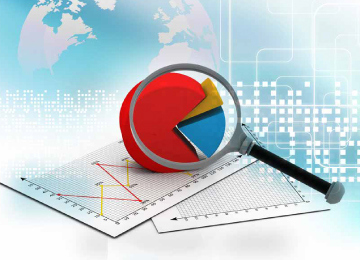HR Connect
Human Resources & Data Analytics : Some Reflections
Volume 2 Issue 1 June 2018 : By Dr. A Jagan Mohan Reddy
Introduction
As we all are aware, disruptive technological developments that are taking place are consistently blurring the lines separating the physical world from the virtual world. Similarly, traditional HR function, representing an industrial enterprise model, has transformed overtime and become a strategic partner, with present emphasis being on Talent Management. Further, technology, robotics, and analytics are fast gaining importance. The use of data for decision making was there in practice for quite some time. But with big data and analytics, people in HR are also forced to use the data and analytics (Human Resource Analytics-HRA) to gain much-needed insights into the human behavior for accomplishing organizational objectives. Because in a competitive world of today given the equal accessibility, availability, and affordability of all other resources, it’s the talented Human Resource alone that provides the much-needed cutting edge.
How Technology and Data Helps
The automation of employees’ life cycle will enable management to get human capital insights through data. And one of the biggest areas, where one could utilize and work towards expanding footprint on human capital analytics is
sales force effectiveness. This can be done by using all of the data points to ensure that the last mile sales force is productive and efficient in their jobs.
Data also helps in taking predictive views on trends in retention. In VUCA (volatile, uncertain, complex & ambiguous) environment of today, one can’t afford to take a diagnostic view and take a back end view of attrition. Today, various early warning signals have to be identified and decisions have to be taken to retain the key talent. Engagement is another field, where one needs to crack the code & data insight can help to get the pulse of what needs to be measured, monitored and needs to be improved in the organization. And that’s how Human Resource Analytics(HRA)came into being.
What is HRA?
HRA means applying analytics to human resource processes of an organization for improving employee performance (with equal accessibility, availability and affordability of all other resources) and a better return on investment for the organization. It’s not simply gathering data on employee efficiency. Instead what we do in HRA is gather data & use the same to get insights into each process for making effective decisions and improving the processes. So HRA relates business data with that of people data and helps in establishing important connections. Hence, an important function of HRA is to provide data on the impact of HR processes on the organization. Further, it helps in establishing a relationship between HR processes and the business outcomes. And that’s what HRA is all about.
A survey by MIT and IBM reported that companies with a high level of HR analytics had 8% higher sales growth,24% higher net operating income &58% higher sales per employee. Important functions of HR such as talent acquisition, training & development etc., can be improved & effectivity enhanced by applying analytics in their processes. In other words, HRA can help to go deep into problems and issues & guides the managers to gain insights from information at hand. And this can help in making relevant decisions and take appropriate actions.
How to Use HRA?
So the question that may arise as to, how companies can use HRA to improve their processes and thereby the operational performance?
First, companies need software, which is available in the market. Secondly, company requires people in HR who knows how to mine and interpret the data. Otherwise simply procuring software doesn’t serve the purpose. Analytics is an important tool/technique for all types of business and HR too needs this. With severe competition around, organizations need to do well. And, as we all know, what can’t be measured can’t be managed. So, companies are looking for metrics or analytics in HR. And these are not just related to people but processes as well such as recruitment, retention, compensation, training & development, performance appraisal etc.,
Further, few might think that HRA is only gathering data on the employee. But that’s not true. The main function of HRA is to provide insights into each process by using data. And these insights help in making relevant decisions so that processes and operational performance could be improved. As we all know, HR collects lot of data on employee’s personal information, compensation, benefits, retirements, attrition, and performance from time to time. And if we use these huge masses of data properly to analyze/interpret the outcomes that will definitely facilitate making effective decisions. Thus, HRS helps in:
- Improving organizational performance through talent-related decisions
- Forecasting workforce requirements/utilization for improved business performance.
- Knowing the reasons for employee attrition especially of high performing employees.
- Knowing the factors that cause employee satisfaction and productivity.
- Determining individual KPIs in Business
- HR impact in realizing organizational goals.
Having looked at the concept, meaning and benefits of HRA, let’s see how few innovative organizations have already begun their journey in this regard:
At Walt Disney, First, HR department tried to understand the sales performance and attrition. They were using Salesforce platform and hence there was lot of data to work with. And they merged that data with people data into their core platforms. This was done so that data being captured in sales platform can be used to drive/ push people’s Strategy.
At Facebook, for optimizing insights into their workforce they formed three names: First one was Data Engineers, whose job was to do sophisticated data structuring and manipulation to create dashboards. And this was fed to other two teams to analyze and inform decisions. Second team focused on answering questions about daily happenings like why did attrition increase by 7%? Third team was to answer questions about what’s going to happen tomorrow.
At Google, as the company was growing, and headcount was doubling every year, they felt the need for a different approach to talent. Accordingly, they have launched a tiger approach, i.e. Diverse group of specialists, such as a recruiting leader, an HR analytics expert, an HR Business partner, an engineering client coming together to pool up their expertise for solving business related problems.
The future of HR analytics
As of now, not many in HR are using predictive analytics. For industry leaders, the next challenge in this regard would be implementing sophisticated machine learning models. And if a company is able to use platform data, it could get accurate in our predictions. Manu Narang Waxhaw, Head HR, Coca-Cola India & South West Asia in a webcast organized by People Matters and moderated by Ester Martinez, CEO & Chief Editor, People Matters said that data on human capital insights to drive business decisions has been another game changer.
Conclusion
Data was at the back of most of the decisions in the past as well. But given the VUCA (volatile, uncertain, complex & ambiguous) environment in which they are operating, most of the companies started capturing and analyzing big data for better understanding of their business, targeting customers more accurately and most importantly cutting costs through improved business processes. Similarly, HR can process/analyze huge mass of structured & unstructured data to answer important questions regarding workforce productivity, the impact of training programs on enterprise performance, predictors of workforce attrition etc., It’s time HR professionals figure out how to use analytics to enable better decision making for accomplishing organizational objectives. Organizations using HRA benefitted from it with data bringing much needed precision to their decisions and the value that these decisions bring to the organization. But one should keep in mind that analytics is not measured based on size but on the basis of impact of such data driven decisions and their impact. So merely creating only reports with data will not add value to decision making and optimization. Instead it will increase cost for the companies.
Lastly, let me conclude with Charles Darwin’s quote
“It’s not the strongest of the species that survive, nor the most intelligent, but the one most responsive to change “. So, change is a must but, in this regard, let’s keep one thing in mind that analytics is a journey, not a goal...
Dr. A. Jagan Mohan Reddy, is Professor of Human Resource Management and Ethics at Symbiosis Institute of Business Management, Hyderabad. He has more than two decades of Industry experience and for the last 16 years he is in the teaching-cum-research field. He is a Life Member of National Institute of Personnel Management and NHRD








